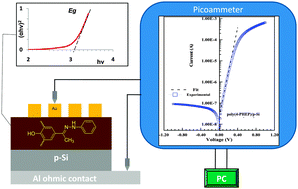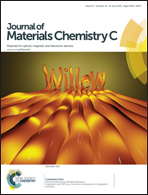Synthesis, characterization and diode application of poly(4-(1-(2-phenylhydrazono)ethyl)phenol)†
Abstract
Poly(phenoxy-ketimine)s, which have a conjugated bond system, are a family of polyphenols that can be prepared by oxidative polycondensation reaction from a monomer containing both hydroxyl (–OH) and ketimine side groups. In this context, a novel poly(phenoxy-ketimine), poly(4-(1-(2-phenylhydrazono)ethyl)phenol), abbreviated as poly(4-PHEP), which includes a system of conjugated bonds and active hydroxyl groups, was synthesized and spectroscopically characterized by elemental analysis, FTIR (Fourier transform infrared) spectroscopy, NMR (nuclear magnetic resonance) absorption and fluorescence spectroscopy. The optical band gap of the polymer is determined to be 3.05 eV. In addition, electrical conductivity, solubility and thermal properties of poly(4-PHEP) were determined. Its electrical conductivity was found to be ∼8.55 × 10−2 S cm−1, which is the typical level for semiconductors. Afterwards, a polymer/p-type Si junction device was fabricated, and its rectifying behaviours, depending on some parameters including ideality factor, barrier height and series resistance values at room temperature, were examined by current–voltage (I–V) and capacitance–voltage (C–V) measurements. Consequently, these interesting properties of the polymer reveal that it has potentially beneficial applications in various fields of electronics as semiconducting materials.


 Please wait while we load your content...
Please wait while we load your content...